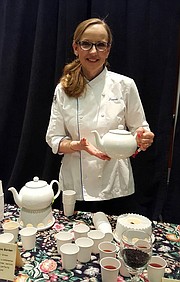Laurie Bell’s Great Falls Tea Garden business consists of seminars for the public, and custom-blended teas for restaurants and retail sale. Photos contributed
Tea-lovers may enjoy their morning brew, but maybe few know the history of the steaming cup that awakens the palate and starts their day. Historians quibble: was it the Indian prophet Prince Bodhi-Dharma in the early 500s AD? Or is it the Chinese legend about the Chinese emperor Shen Nung, who in 2737 BC was sipping hot water under a tree when some of its leaves drifted into his cup. The leaves? Camellia sinensis.
From that Chinese cuppa’ to its global fan club, tea has certainly made its mark in the culinary world. And one of its local advocates and instructors is Laurie Bell, who runs a tea business in Great Falls called Great Falls Tea Garden.
Well-known locally for her former Great Falls catering business called A La Belle Cuisine, Bell has left the cookpots for the teapots because she wants the world to learn about and appreciate the nuances of premium loose leaf teas.
Of course, most people will wonder: why tea? It was really a family matter, Bell explained, one that started with her grandmother. “She would serve tea every afternoon, and I had it with milk and sugar,” she said. “Through all my world travels I got to know more about tea than just tea bags. It’s as varied in its delicious nuances as wine and you can drink all you want and still drive. I studied with the Specialty Tea Institute to become a tea specialist and I go to tea conferences every year,” she said, adding that she never had a cup of coffee until she was 35 years old.
With her pronounced passion for all things teas, it is no surprise that Bell channeled her culinary energies towards understanding and creating tea flavors. After about 10 years of tea studies, experimenting and creating, and attending conferences and reading tea treatises, she started her tea business that consists of seminars for the public, and custom-blended teas for restaurants and retail sale.
Because tea in all its iterations is the most consumed beverage in the world after water, Bell discovered that almost every population and every country has it own tea culture and how they brew and consume their teas. She also discovered that every variable — whites, greens, oolongs, and blacks—all come from the same plant. What makes the difference in color and flavors is when the leaves are picked, in what climate and region (terroir), and the masterful processing of the leaf.
Many countries around the world process and drink straight green teas while other countries process their teas into oolongs or blacks. The seminars are structured so attendees can taste a variety of each style and learn how, for example, a black tea grown and processed in China will taste different from those grown and processed in India, Sri Lanka or Kenya. Or how a lightly oxidized oolong will taste quite different from a heavily oxidized oolong. So for Bell it has made sense to structure her class teachings on appreciating single-origin teas.
Her website gives tea-drinkers the locations of where to savor some of her custom-blended teas as well as some classic teas and flavors. It also details where Bell gives seminars and how to attend them.
Laurie Bell’s Smoky Tea Cornbread
The ingredients in this cornbread are fairly standard. What makes this recipe so tasty and unique is the use of cornmeal stone ground from the historic Colvin Run Mill, and some Lapsang Souchong tea. The tea adds a bit of smokiness to the flavor combination lending a familiar taste reminiscent of bacon but without the meat. Serve warm or room temperature. It stays moist for two days if wrapped well. Enjoy, warm, at room temperature, or briefly reheated.
Serves 9
1 tablepoon Lapsang Souchong tea leaves, dry
1 1/2 cups cornmeal, preferable stone ground from Colvin Run Mill
1/2 cup all-purpose flour
4 teaspoon baking powder
1 tsp sugar
1/2 tsp salt
1 egg
1 1/2 cups milk (whole, lowfat, or skim is fine)
1 tablespoon canola oil or melted butter
Preheat oven to 425 degrees. Grease or spray an 8 x 8- or 9 x 9-inch-square pan.
Finely grind the dry tea in a spice grinder. This will yield about 1 1/2 tsp. ground tea leaves.
Combine ground tea with other dry ingredients. In separate bowl, beat egg, and add milk and oil to blend. Fold in blended liquids to dry ingredients and stir briefly until just mixed. Pour batter into prepared pan.
Bake for 25 minutes until lightly browned on top and the sides are separated from the pan; check after 20 minutes for a 9x9-inch pan. Cool slightly before cutting.
Variations:
- Stone ground whole wheat flour from Colvin Run Mill may be substituted for the all-purpose flour and/or some of the corn meal
- Try this recipe with other teas for a variety of flavor combinations
- Add some corn (off the cob or frozen/defrosted) to the batter
- Add chopped nuts, shredded or diced cheese, and/or fruit to the batter
- To make a sweeter cornbread, add 1 or 2 additional Tablespoons of sugar to the dry mixture; and/or sprinkle some sugar on top of the unbaked batter after filling the pan
- May also be baked in a greased muffin pan for corn muffins. Bake 15 - 20 minutes, depending on size
Experiment and enjoy.

